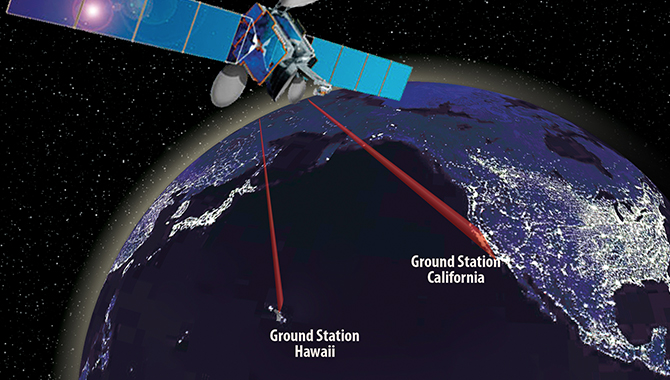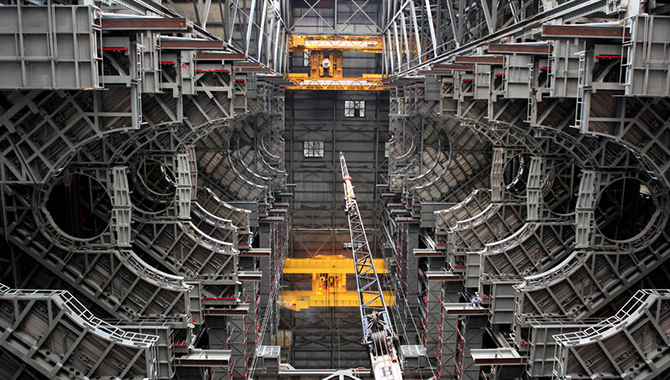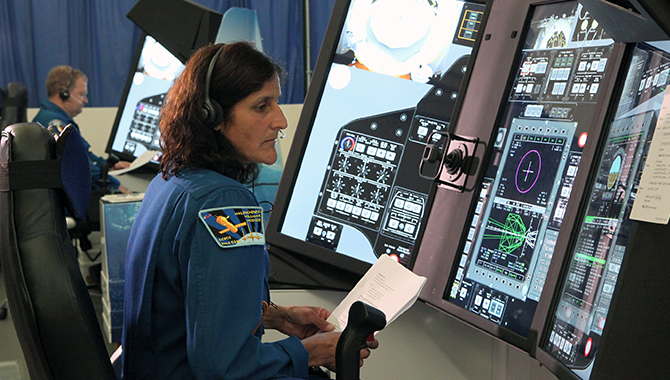
Conceptual image of Laser Communications Relay Demonstration.
Photo Credit: NASA
Future space communications will be more flexible, scalable and affordable, thanks in part to an integrated architecture.
Editor’s Note: NASA’s Office of the Chief Engineer and the Human Exploration and Operations Mission Directorate sponsored the Human Spaceflight Knowledge Sharing Forum in November 2016. Select individuals responsible for shaping NASA’s future over the next 10 to 20 years focused on technical best practices and lessons learned from successful and unsuccessful human spaceflight missions. This is part of a series of articles recapping lessons learned and knowledge shared by these individuals at the pilot knowledge sharing event.
NASA networks span the globe and cover the solar system. NASA’s current space communications architecture includes the Deep Space Network, Near Earth Network and Space Network with 20 ground stations or facilities across all seven continents. The networks provide service to over 100 missions every day, continuous coverage of the Deep Space environment, and coverage from pole to pole via nine tracking and data relay satellites. The networks are a combination of NASA and commercially owned and operated assets and services.
Different services and processes are offered between each of the current space communications networks, and an effort is underway to standardize and optimize communications for future missions. NASA Space Communications and Navigation (SCaN) Chief Architect James Schier says enough progress has been made on future space communications architecture to define a vision.
James Schier.Photo Credit: NASA
“We’re starting to outline a path on how we’re going to get there,” Schier said during his “Future of Space Communications” presentation at the Human Spaceflight Knowledge Sharing Forum. “We’ve identified projections for the mission needs for both science and exploration for 25 years, so we have a good idea of how much traffic we’re going to have to provide for, in terms of capacity. But we’re also defining the architecture so that it is scalable to meet unanticipated growth.”
Vision for Next Generation Architecture
The new NASA SCaN integrated network architecture responds to challenging mission and programmatic requirements and the call for new, enhanced communications capabilities. Schier said adopting a common architecture for lunar, Earth and Mars networks will reduce technology and development costs and allow reuse of hardware and software. He outlined the vision for the next generation architecture:
- “Shrink” the solar system by connecting the principal investigator (PI) more closely to the instrument or experiment, the mission controller to the spacecraft, and the astronaut to the public audience
- Improve the mission’s experience and reduce mission burden in terms of the effort and cost required to design and operate spacecraft to receive services from the SCaN Network
- Reduce network burden, including the effort and cost required to design, operate and sustain the SCaN Network as it provides services to missions with the collateral benefit of increasing funding for communications and navigation technology
- Apply new and enhanced capabilities of terrestrial telecommunications and navigation to space by leveraging other organizations’ investments
- Enable growth of the domestic commercial space market to provide — and NASA to use — commercial services currently dominated by government capabilities
- Enable greater international collaboration and lower costs in space by establishing an open architecture with interoperable services that foster commercial competition and can be adopted by international agencies as well as NASA
Schier says part of the strategy for implementing the vision is to offer incentives for NASA missions to adopt the new approach, offering lower mission burden in terms of size, weight and power (SWaP) and cost parameters. “We want to make it more appealing for the users in the future to adopt new services and go with new capabilities than to stick with the good old legacy stuff that they’re more familiar and comfortable with. At the same time, we want to improve the mission experience,” said Schier, referring to efforts to streamline how missions design their communications subsystems and Mission Operations Centers (MOC) as well as how they negotiate support from the SCaN Network.
Paradigm Shifts
Schier said implementation of the flexible, scalable and affordable architecture will require six key paradigm shifts.
- Current: RF → Future: RF + Optical
Optical communications technology promises high data rates with low SWaP and cost for users. The optical terminal requires extremely precise pointing but has built-in vibration isolation that avoids imposing extremely high stability on the spacecraft bus, thus eliminating the need for a gimbaled antenna. The Laser Communications Relay Demo (LCRD) is set to launch in 2019 and become the first operational optical asset in 2021.
- Current: Single Access → Future: Multiple Access
Multiple access enables one network antenna to talk to multiple users simultaneously in the same overall system bandwidth, a significant improvement over single access, which points one network antenna to one user antenna and commits both for the duration of an event. The Next Gen approach introduces demand access service where the user requests access when needed and gets the necessary bandwidth.
- Current: Scheduled Access → Future: Unscheduled Access
Unscheduled access will enable further system automation and operations cost reduction, while eliminating scheduling for most missions. The current, scheduled access process is labor-intensive and requires missions to schedule events days or weeks in advance. The Next Gen approach introduces demand access services, and shifts from the unreliable link layer to guaranteed network layer service using Disruption Tolerant Networking (DTN).
- Current: Ku-band → Future: Ka-band
Ka-band can provide higher data rates at higher frequencies with lower spacecraft SWaP. The Next Gen approach to eliminate Ku-band from Next Gen Earth Relays and incorporate Ka-band capability on all new 34-meter Deep Space Network antennas also includes investing in user terminals to bring cost down and overcome user community reluctance to adopt Ka-band.
- Current: Link Layer Services → Future: Network Layer Services
Link layer services don’t guarantee data delivery forcing MOCs to develop software to process data for errors, resend data, and issue commands to delete data from memory. As part of reducing mission burden, the Next Gen approach includes space internetworking — the Solar System Internet (SSI) — that guarantees delivery and reduces burden on ground and flight segments, enables a Service-Oriented Architecture (SOA) providing access to additional applications, and offers the ability to move data directly from MOCs to PIs or directly from spacecraft to PIs.
- Current: Different Near-Earth and Deep Space Architectures → Future: Common Architecture
Instead of distinct networks, a common architecture will integrate space- and ground-based assets used to provide service to everything from within the near-Earth domain to Deep Space. A common architecture would help simplify mission concept definition and implementation when moving from Earth into the lunar environment, Mars and beyond. The Next Gen approach builds in resiliency that has not existed previously in space communications assets.
Advancing Communications Technology
Schier said NASA wants to take advantage of advances in space communications technology. “The equation has changed. Right? We’re no longer just the leader in technologies. We need to be the adapter of commercially available technologies,” he said. “We want to make sure that we’re working with industry to stimulate their adoption of new technologies and use that to help increase the rate of expansion of commercial space development.”
Universal collaboration is part of the vision for future space communications. “We want to continue to work with our international partners and, in fact, expand that so that our future architecture is — like the internet — adopted by everybody in the universe, which will help make it more reliable, more prevalent, and increase the capability of service while reducing the cost of acquisition and operation,” said Schier.
The Next Gen Architecture Concept Review is planned in late 2018.
Related Video:
| James Schier’s Human Spaceflight Knowledge Sharing Forum presentation on the Future of Space Communications |









